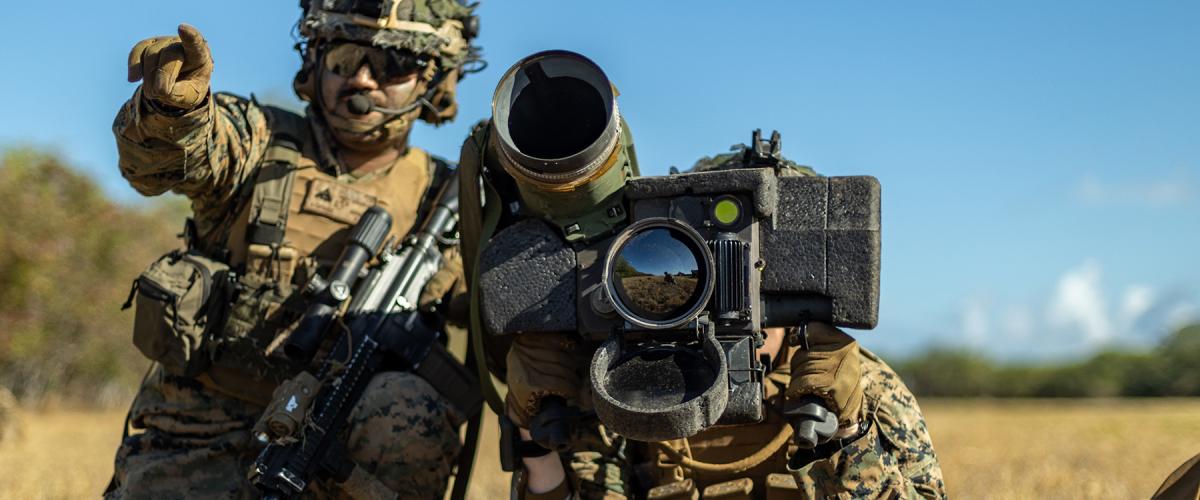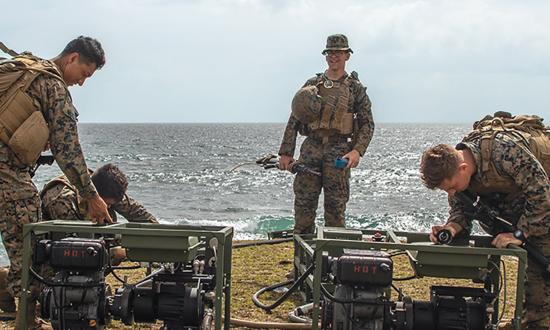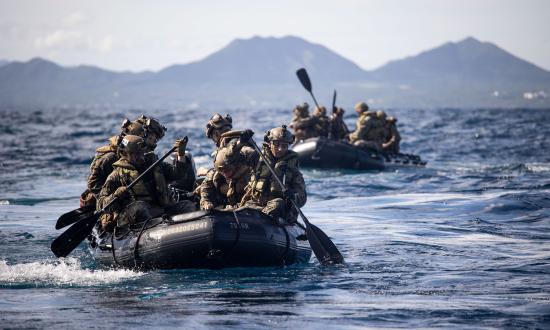In his monumental history of the U.S. Marine Corps, Professor Allan Millett noted the service has gone through four epochs: Soldiers at Sea, Colonial Infantry, Amphibious Assault Force, and Force in Readiness.1 As the Marine Corps again faces a rapidly changing environment, it is essential to draw on this legacy of innovation to meet emerging threats. The Marine Corps has again stolen a march with Force Design 2030, but further course corrections will significantly enhance its utility.
Time to Change—Again
Four imperatives require Marines to rethink their operational concepts and force structure. First, the Secretary of Defense has specifically tasked the Marine Corps to focus on China as the number one challenge. Unfortunately, the service’s current organization provides little useful capability in a conflict with China. Second, today’s force is outranged by current and emerging adversary weapon systems. Third, the emergence of pervasive surveillance and autonomous precision weapons are making the defense tactically dominant again. Fourth, current Marine organizations require massive logistics support that, as the Russians are discovering, is a huge vulnerability when the enemy has effective surveillance and long-range weapons. Since both are becoming ubiquitous, the Marine Corps must find a way to be effective with a fraction of its current required logistics support.
Force Design 2030 is a good first step. By providing a reconnaissance/counterreconnaissance capability and limited long-range fires, the Design provides combat commands and fleet commanders with forces relevant for the fights they face. Marines have usually been the supported force, but in the future they will find themselves a supporting force to the joint or naval task force commander. While the focus has been on China, the new organization has already proved effective in U.S. European Command operations. It could be just as valuable in the Baltic and Black Seas or in the Persian Gulf. However, Force Design 2030 is just the first step necessary to fight in an era of massed, autonomous precision weapons enabled by pervasive surveillance.
Pervasive Surveillance
Pervasive surveillance is a direct result of the massive expansion of commercial space and drone assets. Today, the planet is being imaged virtually and continuously by an ever-thickening network of visual, infrared, synthetic aperture radars and electromagnetic sensors. Bad weather and foliage no longer provide concealment. By 2030, 100,000 satellites are projected to be in orbit, with thousands dedicated to earth observation.
In addition, both commercial firms and governments are developing more capable surveillance drones. Flight times have increased dramatically too. Vertical takeoff and landing (VTOL) drones have an endurance of 11 hours while airfield-based drones can fly for 120 hours.
To deal with this mass of information, commercial firms have developed change detection software that can detect, plot, and display the movement of military forces on a near-continuous basis—for a fee.
Long-Range Precision Strike
Listing the global proliferation of long-range, precision missiles and drones would take an entire book. Many not only outrange tanks and field artillery, but also the F-35 Joint Strike Fighter. Taiwan’s Revolver 860 VTOL drone can carry up to eight 60-mm mortar rounds with an endurance of 40 minutes. The $1,000 hand-launched, Australian-produced Drone 40 weighs less than a pound but has a range of 15 kilometers. Nor is precision delivery limited to military drones. Numerous videos from Ukraine show commercial quad and octocopters dropping small antipersonnel and antiarmor munitions with devastating effects.
Mass Precision Is Coming Fast
In 2014, an aeronautics professor took only 28 hours to 3D-print and assemble an autonomous drone he designed. Today’s 3D printers are more then 100 times faster. A plant with 100 modern 3D printers could produce 10,000 of these drones per day. The cost of cruise missiles is also dropping rapidly. In addition to the U.S. Air Force–developed $100,000 Gray Wolf cruise missile, Raytheon has almost perfected 3D printing to produce a cruise missile.
Co-evolving concepts, tactics, and commercial and military technologies are creating a battlespace on which movement will be extremely dangerous. If a unit moves, it will create a signal and can be detected, tracked, and attacked at much greater ranges than in the past. At the same time, capabilities in the cyber, space, and electromagnetic domains will provide both reinforcement for and increasingly powerful alternatives to kinetic attacks. Mass is returning—but this time with precision.
How to Survive
In the emerging era of persistent surveillance, remaining undetected on the battlefield will require one of two approaches. First, establish overhead cover either by digging in or by moving into already existing structures. Second, ensure units blend into the surrounding environment by employing “ordinary vehicles that can be moved to almost any place on earth without attracting attention.” Dispersion and deception must come to the fore.
Concept of Operations
The Marine Corps’ Inside Force concept recognizes that deploying aircraft to airfields or sailing major ship platforms within range of China’s growing A2/AD network is increasingly dangerous. Yet, a key element for success in a war with China will be containing its naval and trade vessels within the first island chain. Fortunately, there are fewer than ten major exits from the South and East China Seas suitable for large ships. Even the widest, the Bashi Channel, is only about 100 miles. Unfortunately, fixed airbases and even temporary forward-operating and refueling platforms in the northern Philippines and much of Japan lie inside China’s A2/AD umbrella. Major surface combatants will also be at significant risk.
This is where the Marine littoral regiment’s (MLR’s) ISR and fires capabilities can make major contributions to the Joint Force in ways traditional Marine regiments simply cannot. The MLR, operating containerized missiles, will be extremely difficult to target. It can provide continuous surveillance and responsive fires in the straits. This capability can also be used along the littorals of Nordic, Baltic, Aegean, and Arabian Gulf nations as well.
To heighten readiness and express resolve during peacetime, the MLR can conduct combined operations with allies and friends in the region. Japan has five regiments of improved antiship cruise missiles (ASCMs). The Philippine Navy is buying three batteries of Brahmos ground-based ASCMs for its Marine Corps. Indonesia is also planning to acquire Brahmos systems. Singapore is developing new ASCMs. The proliferation of these systems greatly complicates Chinese planning in the region, as well as providing capabilities for allied and friendly forces to deny China freedom of action in the region.
A Future MLR
To be successful in this emerging environment, the MLR needs more reconnaissance/counterreconnaissance, a great deal more fires, and a shift to commercial vehicles/containerized weapons to reduce logistics demand and increase survivability.
Guiding Principles for Revised Force Structure
- The MLR’s primary missions are to provide ISR and fires for the joint or naval task force commander. Both capabilities require significant upgrades.
- Commanders down to the firing battery level must have ISR assets that provide them with a picture out to the range of their weapons. This will ensure they can continue to execute mission orders even if communication with higher headquarters is cut off.
- Units must blend with the environment. Therefore, commercial vehicles and containers should be the norm.
- The MLR must function with minimal or no communication with higher headquarters by using mission orders. MLR units must strive to remain linked via local, low probability of intercept networks that also communicate with naval forces operating in the area but remain equipped to operate in absence of orders.
- The MLR must be able to exploit the evolving family of unmanned, long-endurance, small watercraft sensors.
- Upgrades must focus on weapons and capabilities, not platforms. Platforms simply exist to transport the capabilities.
Reconnaissance/Counterreconnaissance
Traditional ground-based visual surveillance is inadequate. The MLR must include drones capable of multispectral, electromagnetic, search and rescue, and passive radar surveillance of broad areas. Each element of the MLR requires its own reconnaissance capability. At the regimental level, this will include long-range, long-endurance drones, ground-based multispectral and passive electronic support measures, radar, and connectivity to space assets where possible.
Firepower
The current MLR has four infantry companies but only one ground-based antiship missile battery. Unfortunately, the infantry companies provide little added value to a naval task force. A second generation MLR should have four rocket batteries and only enough infantry company organized to provide local security for the batteries. Each battery should be manned to control six dispersed containerized launchers. Containerization enhances survivability, minimizes manpower, and eases resupply. Even small ports have material handling equipment for 20- and 40-foot containers as well as the trucks to move them forward.
The greater number of firing batteries provides the mass necessary for an effective attack on modern warships. If equipped with Naval Strike Missiles, multiple batteries could engage any ship attempting to pass through exits from the South China Sea, Red Sea, Baltic Sea, Arabian Gulf, Aegean Sea, or any other restricted body of water. This allows them to provide timely support to the naval task force commander. Increased firepower means the MLR can also take on a primary mission of distant blockade by dominating these limited passages. The four batteries in an MLR could reinforce each other while remaining very widely dispersed for survivability.
Until they open fire, containerized missiles carried by commercial vehicles will be nearly impossible to target among the thousands of commercial containers in the urban and commercial clutter of a developed nation. Once they fire, the enemy will be shooting back at an empty box. Perhaps most important, the Marine Corps will be able to rapidly upgrade the range and lethality of its missiles by focusing on weapons rather than platforms.
Contested Logistics
Logistic support for widely dispersed forces will remain a major challenge. The Marine Corps has successfully experimented with “foraging” or purchasing logistics support from companies in the host nation. This is a good initial step, but MLR units should tailor themselves to take maximum advantage of local logistics. An MLR of a couple thousand Marines and their equipment will not burden the civilian logistics support networks of the Philippines (population: 110 million) or even a small Baltic State like Estonia (1.3 million). By purchasing local vehicles, MLR units will blend in and be able to procure fuel, parts, and maintenance locally. They can also purchase food, water, batteries, and even some types of medical support from the local economy. If the MLRs deploy to underdeveloped regions, they bring their own vehicles but will have to plan for additional logistical support. A critical step will be providing authority and funds down to at least the company/battery level.
Potential Marine Outside Force
In the Indo-Pacific, most of the units of the Force Design 2030 Marine Corps lack the range to engage. However, by mixing legacy systems and new capabilities, Marine aviation has the potential to support both the joint commander and the MLR in three areas. First, the Marine Corps’ massive investment in F-35s means Marine Air can contribute to the defense of the Second Island Chain, and the southern part of the First. If their support facilities remain operational, the F-35s can provide air and cruise missile defense and attack any Chinese shipping within range. Second, if it adopts the Cargo Launch Expendable Air Vehicles with Extended Range (CLEAVER) family of munitions, Marine aviation can employ its KC-130 Hercules fleet to deliver long-range (more than 1,000 miles from the weapons-release point) precision munitions. Finally, the Marine Corps can adopt long-endurance surveillance craft like the Aurora Orion. This platform could provide critical ISR and communication relay even if the aircraft are forced to operate from well outside the first island chain.
Looking Forward
Through four previous epochs, the Marine Corps has innovated to meet the challenges of emerging environments. The dramatically changing strategic balance in Asia augmented by massive technological advances in surveillance and long-range fires represent the challenges that past Marines met with innovative conceptual, doctrinal, and organizational changes. Force Design 2030 is a great first step toward meeting these challenges—but only the first step. Marines must understand the implications of change and aggressively expand on the current innovations.
1. Allan R. Millett, Semper Fidelis: The History of the United States Marine Corps (New York: MacMillan Publishing Company, 1980).






